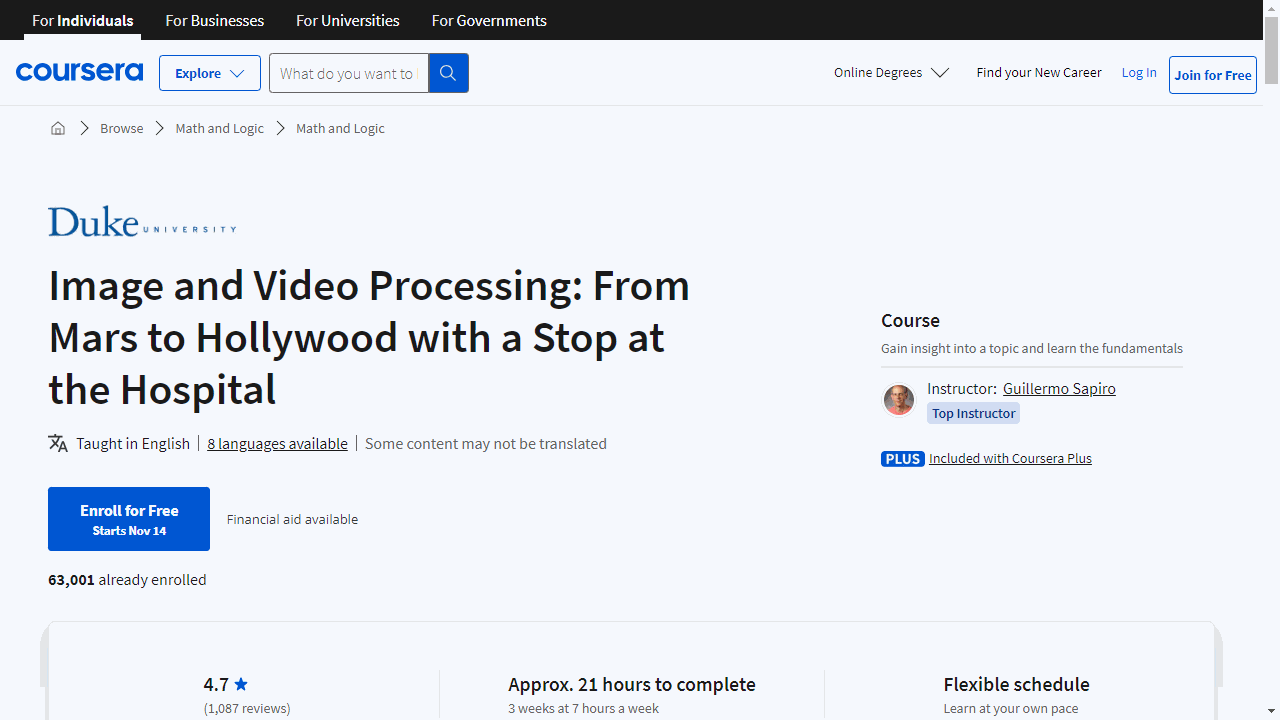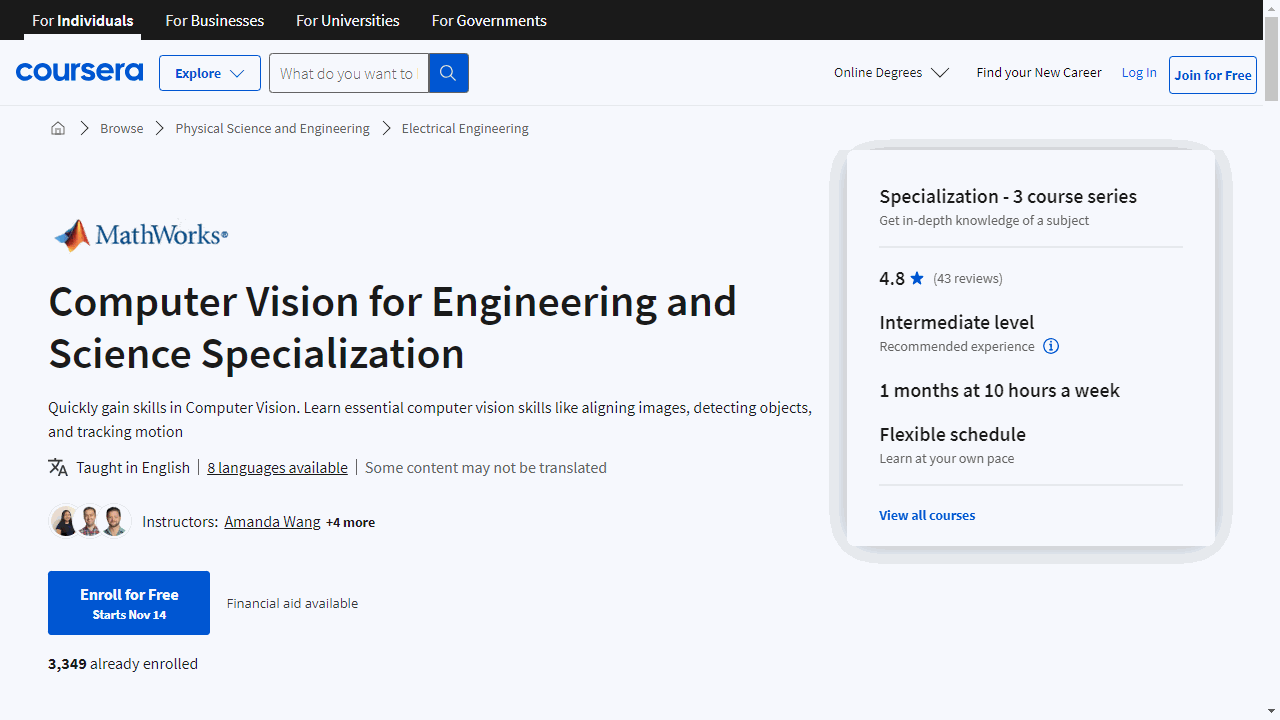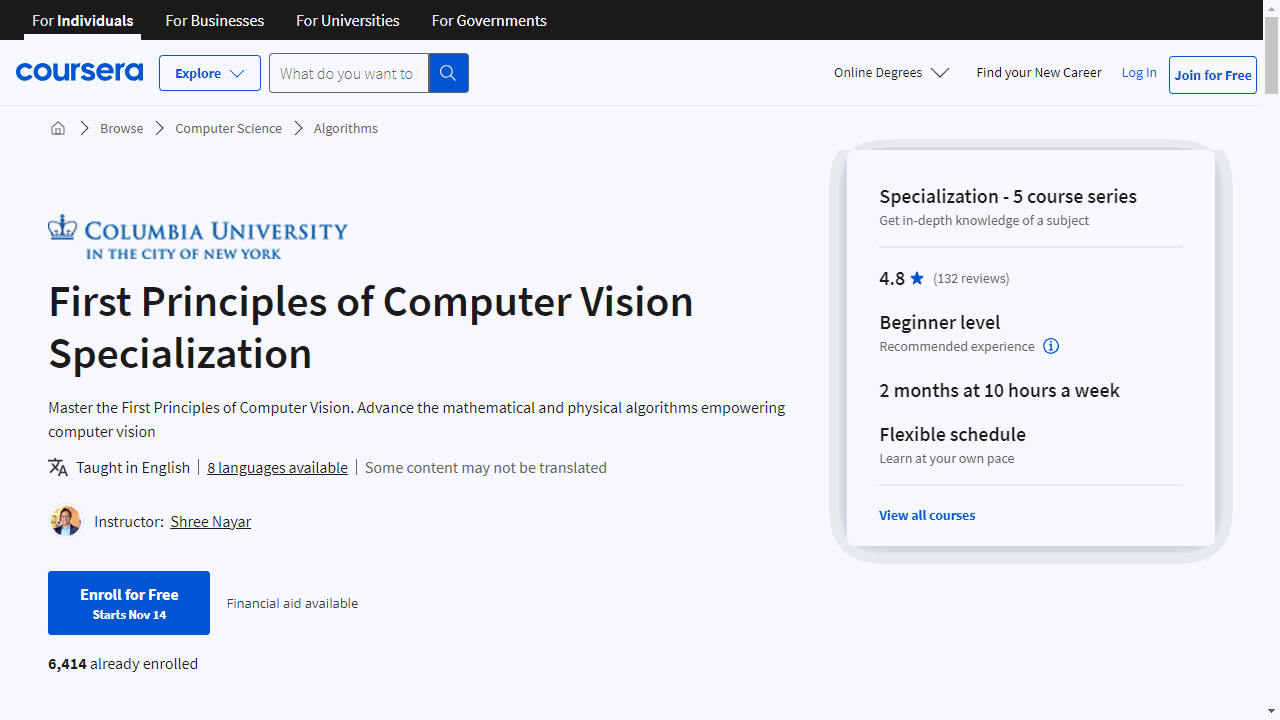Image processing is a vital field that involves manipulating digital images to extract information, enhance their quality, or create new visuals.
It’s a cornerstone of numerous industries, from healthcare to engineering and beyond.
By learning image processing, you can unlock a world of possibilities, from analyzing medical scans to developing self-driving cars.
Finding the right image processing course on Coursera can be overwhelming, given the vast array of options available.
You’re looking for a program that’s comprehensive, engaging, and taught by experts, but also caters to your specific learning style and career goals.
For the best image processing course overall on Coursera, we recommend the "Image Processing for Engineering and Science Specialization" from MathWorks.
This specialization is meticulously designed to guide you through the complexities of image processing using MATLAB, a widely-used software in engineering and science.
It covers a wide range of topics, from fundamental image manipulation to advanced techniques like segmentation and automation, providing a solid foundation for your image processing journey.
While this program is our top pick, there are many other excellent image processing courses on Coursera.
Keep reading to discover our recommendations for various learning levels, specific areas of image processing, and career goals.
Image Processing for Engineering and Science Specialization
This series of courses is meticulously designed to guide you through the complexities of image processing using MATLAB.
The journey begins with “Introduction to Image Processing,” where you’ll learn the fundamentals of handling digital images.
This course equips you with the skills to adjust image properties and introduces you to segmentation and quantitative analysis.
You’ll gain practical experience by working on a project that involves analyzing satellite imagery to detect surface water—a skill that’s not only fascinating but also incredibly useful.
Building on that foundation, “Image Segmentation, Filtering, and Region Analysis” delves into more advanced techniques.
You’ll tackle challenges such as image noise and learn to apply spatial filters.
The course also covers edge detection and clustering, providing you with a robust toolkit for image analysis.
By the end, you’ll be able to segment complex images, such as MRI scans, to isolate different tissues, enhancing both your understanding and your resume.
The final course, “Automating Image Processing,” teaches you to efficiently process large image datasets.
Automation is key in managing extensive data, and this course shows you how to implement it effectively.
The capstone project simulates a real-world scenario where you’ll analyze traffic patterns from video footage, a task that demonstrates the practical application of your new skills.
A basic math background and some exposure to MATLAB are recommended, but you don’t need prior experience in image processing to begin.
This specialization is not just about learning theory; it’s about applying what you learn to real-world scenarios.
You’ll emerge with the ability to enhance, segment, and automate image processing tasks, a skill set that’s in high demand across various industries.
Computer Vision for Engineering and Science Specialization
The journey begins with “Introduction to Computer Vision,” where you’ll grasp the basics of how computers interpret visual data.
You’ll delve into algorithms that allow you to align and stitch images, a skill that’s invaluable for creating detailed panoramic images or analyzing satellite data.
Image registration, a critical component for comparing and combining images, is also covered in depth.
The course is hands-on, with MATLAB as the primary tool, ensuring you’re learning with software that’s respected in the engineering and science fields.
Moving on to “Machine Learning for Computer Vision,” you’ll explore the intersection of computer vision and machine learning.
This course empowers you to train models for image classification and object detection, applying these skills to practical scenarios like identifying street signs or spotting manufacturing defects.
The course emphasizes the machine learning workflow, from data preparation to model evaluation, reinforcing your learning with real-world applications.
The final course, “Object Tracking and Motion Detection with Computer Vision,” teaches you to track objects and detect motion within video streams.
Using pre-trained deep neural networks and optical flow, you’ll learn to analyze video data, a skill set that’s increasingly relevant in today’s tech landscape.
The capstone project simulates a real-world challenge, asking you to track and count vehicles on a highway, providing a tangible demonstration of your newly acquired skills.
While some prior experience in image processing is beneficial, beginners can first tackle the “Image Processing for Engineering and Science specialization” to prepare.
In summary, this specialization offers a structured and detailed exploration of computer vision, with MATLAB as a central learning tool.
Image and Video Processing: From Mars to Hollywood with a Stop at the Hospital
This course stands out for its breadth of application, from space exploration to entertainment, and even medical diagnostics.
The course begins with a clear introduction to the fundamentals of image and video processing.
This foundational knowledge is crucial as it’s applied throughout the course.
Understanding the human visual system is essential for grasping image processing concepts.
You’ll then explore how images are created through lessons on sampling and quantization.
Simple image operations are up next, where you start applying your knowledge.
The course ensures that these early lessons are practical and not overwhelming, setting you up for success as you progress.
Compression techniques are vital in this field, and the course covers them thoroughly.
You’ll learn about Huffman coding and delve into JPEG and MPEG standards.
The content is broken into segments with optional breaks, allowing you to learn at a comfortable pace.
Image enhancement techniques are presented with clarity.
You’ll engage with methods like histogram equalization and local neighborhood operations, reinforced with practical demos that help solidify your learning.
The course also tackles the challenge of noise in images.
You’ll understand different noise types and how to apply Wiener filtering for image restoration.
The included demos are particularly helpful, showing you the practical application of these techniques.
Segmentation, a crucial aspect of image processing, is covered with depth.
The course includes interactive elements like the Hough Transform in Matlab, ensuring you not only learn the theory but also how to apply it.
PDEs in image processing might seem daunting, but the course introduces them in an accessible way.
You’ll learn about their role in applications such as object tracking in videos, with curve evolution and active contours as key topics.
Inpainting is demystified in this course, showing you how to seamlessly remove unwanted elements from images.
The Photoshop demo is a practical touch that illustrates the power of these techniques.
Sparse modeling is presented as an advanced topic, with a thorough introduction and exploration of dictionary learning.
The course provides examples of how sparse modeling is applied in image processing, enhancing your understanding.
It concludes with a foray into medical imaging, demonstrating the real-world impact of image processing.
You’ll see how these skills can contribute to healthcare, particularly in the diagnosis and research of diseases and brain imaging techniques.
Overall, the course is well-structured, with a logical progression from basic concepts to advanced applications.
Fundamentals of Digital Image and Video Processing
Offered by Northwestern University, this course begins by clarifying the distinction between analog and digital signals, setting the stage for a deeper understanding of image and video technology.
You’ll explore how these signals are represented within the electromagnetic spectrum, which is essential for grasping how images are captured and displayed.
As you progress, the course introduces you to discrete signals in both two and three dimensions, as well as complex exponential signals.
These concepts might seem complex at first, but they’re fundamental to digital image processing and are presented in an accessible way.
Key to image enhancement, you’ll learn about linear shift-invariant systems and 2D convolution.
The course doesn’t just stop there; it also teaches you filtering techniques in both the spatial and frequency domains, allowing you to manipulate images to improve clarity or alter their appearance.
Sampling and the Discrete Fourier Transform are also covered, providing you with the knowledge to handle digital images while maintaining their quality.
You’ll also learn about changing sampling rates, which is crucial when working with various image sizes and resolutions.
The course then takes you through motion estimation, where you’ll encounter phase correlation and block matching—techniques that are the backbone of video processing and tracking movement.
When it comes to color image processing, the course offers a progression from introductory concepts to more sophisticated techniques like histogram processing, noise smoothing, and sharpening.
You’ll also delve into homomorphic filtering and pseudo coloring, which can dramatically enhance the visual impact of images.
In the realm of video enhancement and image restoration, the course equips you with the skills to recover and enhance images that may seem degraded.
You’ll become familiar with matrix-vector notation for images and various restoration algorithms, including iterative and adaptive methods.
Compression is another critical topic covered in the course.
You’ll learn about the mechanics behind making files more manageable for sharing and storage, including an understanding of coding techniques and standards like JPEG and MPEG.
Finally, the course introduces advanced methods such as sparsity-promoting norms and matching pursuit.
These techniques are at the forefront of image processing and can be applied to a range of practical scenarios.
First Principles of Computer Vision Specialization
Embarking on the “First Principles of Computer Vision Specialization” on Coursera is a smart move if you’re seeking a solid foundation in image processing.
This suite of courses is meticulously designed to guide you through the essentials of computer vision, ensuring you grasp both the theoretical underpinnings and practical applications.
The journey begins with “Camera and Imaging,” where you’ll unravel the intricacies of how images are captured and processed.
You’ll delve into the workings of image sensors and learn the principles of designing cameras for capturing images in high dynamic range.
The course also equips you with the tools for basic image processing, setting the stage for more advanced exploration.
Moving on to “Features and Boundaries,” you’ll develop the skills to identify key elements within images, such as edges and corners—essential for interpreting and analyzing visual data.
The course introduces you to techniques like active contours and the Hough Transform, enabling you to extract and manipulate features with precision.
In “3D Reconstruction - Single Viewpoint,” the focus shifts to extracting three-dimensional information from two-dimensional representations.
You’ll explore methods like photometric stereo, which reveals the texture and shape of objects, enriching your understanding of how light interacts with surfaces to create the images we see.
The “3D Reconstruction - Multiple Viewpoints” course expands your perspective, teaching you to integrate information from multiple angles to build comprehensive 3D models.
You’ll learn about camera calibration and stereo vision, gaining insights into how these techniques are applied in fields such as robotics and virtual reality.
Lastly, “Visual Perception” addresses the challenge of interpreting and understanding visual data.
This course covers object tracking, image segmentation, and object recognition, culminating in the use of neural networks for classifying and identifying objects.
It’s a deep dive into the cognitive aspects of computer vision, mirroring the way humans perceive and make sense of visual information.
Whether you’re aiming to advance in your career or simply passionate about the field, these courses provide a valuable and enriching learning experience.





